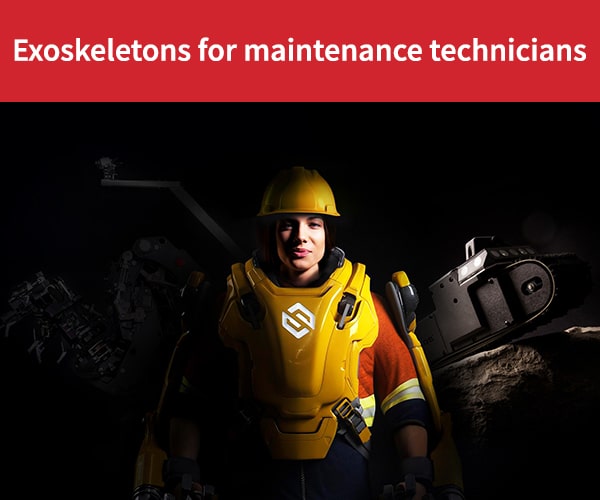
- Maintenance
- Safety
- Technician
- Technicien
Maintenance: how exoskeletons reduce workplace strain
Exoskeletons are used to perform strenuous tasks, such as safely moving heavy loads. In maintenance, the concept lends itself to numerous use cases and companies such as SNCF, the French national railway company, have already adopted the technology. Most of us have seen movies such as Alien, Avatar and Iron Man where heroes are equipped with exoskeletons. But, augmenting human capabilities in this way is no longer limited to science fiction. Military organizations used exoskeletons in the 1970s and, in recent years, they’ve spread to the industrial world. If we go back to the word’s Greek origins, an exoskeleton is an “outer” skeleton. More specifically, it’s motorized equipment that’s attached to one or more limbs on the human body to restore mobility, such as in the case of a person with a disability, or to increase their motor skills, such as in the case of an able-bodied person. The exoskeleton includes mechanical parts that enable certain movements. Neck braces, back braces and other orthopedic aids are included in the exoskeleton family. In industrial applications, exoskeletons strengthen human movements and increase work capacities.
Exoskeletons are already used in industry
Exoskeletons are used to perform strenuous tasks, such as moving heavy loads, without significant effort and in a safe way. These are tasks that can’t be automated. For example, the automotive industry uses exoskeletons to perform physically demanding operations such as assemblies that require people to work while inverted or over their heads. Ford has already equipped workers who regularly have to raise their arms to work with exoskeletons. Exoskeletons are different from industrial robots because they’re fully controlled by the person wearing it, whereas robots operate independently. In the factory of the future, traditional workers, “augmented” operators, industrial robots locked in cages and “cobots” will coexist. These collaborative robots will share the same workspace as humans, performing difficult, repetitive, thankless or dangerous tasks for them.
Exoskeleton technology can be passive or active
There are two types of exoskeletons: passive and active. Non-motorised, passive exoskeletons are based on mechanical systems that don’t remove the weight of the load, but better balance it. For example, the weight is lighter at the arms and shoulders and is distributed across the abdomen or legs. In this case, the exoskeleton acts like a giant corset, helping to prevent occupational injuries that can result from improper movements or prolonged work stances. The passive exoskeleton locks into a sitting, standing or squatting position to reduce pressure on the body and help prevent musculoskeletal disorders (MSDs). However, if exoskeletons are incorrectly used, they can create health risks. The French National Research and Safety Institute completed a very comprehensive assessment of the risks with exoskeletons and advises caution when using them. Most active exoskeletons are still in the R&D phase. These motorised devices weigh at least 15 kg and are up to three times heavier than passive exoskeletons. They can carry loads up to 40 kg, but they’re also limited by their battery life.
Exoskeletons improve working conditions for technicians
As we can see, exoskeletons can help maintenance technicians in a number of tasks to greatly improve working conditions. Technicians are regularly called upon to carry heavy parts and to perform repetitive motions. They may also have to work in restrictive positions to service equipment that’s difficult to access. Service companies that adopt exoskeletons benefit from higher employee productivity and fewer work accidents. Exoskeletons can also be an attractive feature for younger people who are turned off by the arduous nature of the profession.
A French railway company is pioneering use of exoskeletons
SNCF is a pioneer in the field and has partnered with the start-up Ergosanté Technologie to develop an exoskeleton that helps its maintenance technicians. The exoskeleton, which is called Shiva Exo, was shown at the 2019 Viva Tech show in Paris and aims to drastically reduce work hardships. The passive exoskeleton weighs less than 7 kg, adapts to all body types and meets French National Research and Safety Institute standards. It’s designed to prevent shoulder, back and elbow injuries. The mechanical stresses supported by the exoskeleton are redirected to the hips.
Shiva Exo can be used for a variety of tasks
Shiva Exo can be used for tasks that require a person’s arms to be in the air, such jobs that are under a bridge or in a pit. It can also help when people need to lean forward to handle heavy parts and tools such as drills, grinders and impact wrenches. According to Ergosanté Technology, which markets Shiva Exo on its website, the exoskeleton can handle items up to 15 kg. According to an article in the French newspaper, Figaro, the exoskeleton required four years of work, 340 ergonomic studies and was tested at the Bischheim technicenter, near Strasbourg. As a modular exoskeleton, Shiva Exo can be used for a number of use cases, including people working in maintenance and logistics as well as SNCF mechanics and brake technicians. An explanatory video in French is available.
The future looks more like Iron Man
A European exoskeleton project, called Robo-mate, also uses a modular approach that allows the four modules in the exoskeleton to be combined or used separately:
- The torso module supports the hips and torso.
- The passive arm module provides constant lifting power.
- The active arm module provides variable lifting power for gripping and positioning tasks.
- A human-machine interface interacts with the exoskeleton and displays assembly instructions.
An exoskeleton that makes you twenty times stronger
The exoskeleton future that’s taking shape should look more like Tony Stark’s armor in Iron Man. Sarcos Robotics’ Guardian XO Max is an active exoskeleton with an eight-hour battery life that promises to make us 20 times stronger. That means a human will be able to move a 90 kg load, but feel like they’re moving something 20 times lighter — a 4.5 kg load. Watch the video. Guardian XO Max was designed to support its own weight. For safety reasons, its arms are controlled with joysticks. The exoskeleton’s speed of movement has also been limited to avoid sudden movements that could bring the risk of injury.
Our similar articles.
-
- Technician
- Software
- After-sales service
5 tips to get your technicians hooked on your mobile service app
January 25, 2018 -
- Field Service Management
- Technician
- Software
- scheduling
- dispatching
Whitepaper: Improve scheduling & dispatching for your team of field service technicians
September 7, 2023 -
- Field Service Management
- Technician
- Software
Key strategies to encourage adoption of field service management software
September 25, 2018


